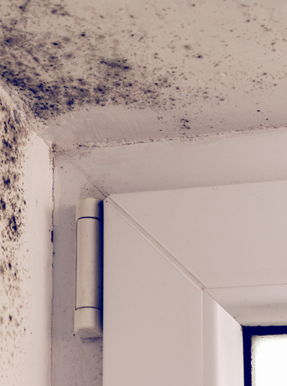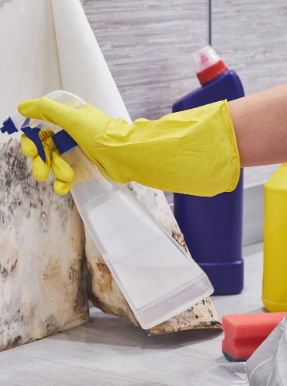
What is Condensation
Nuaire are the inventors of Positive Input Ventilation (PIV): the most effective method of curing and preventing condensation dampness.
Read MoreWhat is condensation?
Condensation is the opposite of evaporation and occurs when water vapour changes state to become liquid water. It usually happens when humid air cools, at which point water vapour condenses into liquid water droplets. It can also happen when the air becomes too humid, beyond its saturation point. Condensation is a key part of the water cycle, forming water droplets in clouds when warm and cold fronts meet. Condensation can also occur when warm and humid air meets a cold surface, such as a window or wall within a home.
A build-up of condensation is a common problem within homes of all types and sizes, especially in the winter months. Over a quarter of British homes (27%) already report an issue with condensation, damp, and mould. As condensation can cause damp and mouldy conditions within houses, it’s an important issue to solve. Luckily, there are clear steps to identify and solve a condensation problem.
This guide explains what causes condensation in households, and how to stop it before it becomes an issue.
What causes condensation?
Condensation in homes and commercial properties will occur when humid air cools or becomes oversaturated with water vapour. Warm air can hold more water vapour than cold air, so any sudden drop in temperature can result in water droplets forming in the right conditions. This is usually when warm air meets cold surfaces like windows or walls. For example, a hot shower will likely create a humid environment with condensation occurring on the cold tiles.
For condensation to occur, the air must have some degree of humidity. Cooking, boiling the kettle, drying clothes inside, and running a shower are all causes of humidity within households. Even the act of breathing releases water vapour into the surroundings. A lack of ventilation may worsen the humidity level of this warm air, increasing the likelihood of condensation occurring. Simply put, humid air cannot escape if there is no ventilation. In this case, the warm air may cause condensation in the colder areas of the house. Extractor fans are a common sight in kitchens and bathrooms for this reason. They help to get rid of excess humid air at the source, stopping it from being dispersed across a house or property.
Condensation is much more common in the winter months for a range of reasons. Households may keep windows shut to keep out the cold and are more likely to dry washed clothes inside. This both shuts off ventilation and increases moisture within the house. Good ventilation can help to decrease this damp, stale air.
Central heating will raise the temperature of the air within the home, in contrast to the cold air outside and any unheated spots in the house will likely be very cold in the winter too. This can result in condensation occurring on cold windows, or unheated interior walls. High levels of condensation can cause significant areas of damp and a whole host of issues.
The main causes of condensation include:
● No radiators or heating in parts of the house such as the hallway or bedroom.
● Drying clothes on radiators or anywhere inside the house releases moisture into the air.
● Cooking in the kitchen or washing in the bathroom without proper ventilation.
● Not fully heating the home in winter, with cold areas attracting condensation.
● Lack of ventilation within the home, meaning stale and humid air is trapped inside.
Signs of condensation
A clear sign of condensation is the build-up of water on cool surfaces within a home. Steamy or fogged windows and mirrors in the bathroom or elsewhere are the more obvious examples of condensation. Look out for water build-up on windowsills or the corner of the window frame overnight.
Dampness on walls, fixtures and furniture is a sign of a condensation problem. Warm, moist air will collide with the cold surface of a wall or window and rapidly drop in temperature. This will form water droplets and can occur on a range of surfaces including fabrics and furniture. With any dampness, there is a risk of mildew, mould or rot. Problem areas are behind furniture or in remote corners of the house. Any mould or mildew should alert the house that the condensation problem has persisted. The most common sign is black mould forming on walls.
The colder areas of the home will be more likely to attract signs of condensation. This could be an unheated bathroom or hallway. Warm air from elsewhere in the home may cause condensation when it cools in these colder parts. Signs of a condensation problem may be a continuously damp room or wall, even when the heating is on. This could lead to damaged plaster, peeling wallpaper or mould on the skirting board.
Signs of condensation may include:
● Water build-up on cool surfaces like tiles, wooden floors, windows and mirrors.
● Peeling wallpaper and cold, damp walls.
● Dank, musty smells.
● Mildew or mould behind sofas, on clothes, or in the corner of rooms.
● Black mould on the skirting boards or walls.
● Dampness in the winter months.
What are the risks of condensation?
Condensation is the sign of a humid environment with a lack of ventilation and can bring a range of risks to both the property and the occupant. Severe condensation over a prolonged period of time can have the same damaging impact as other causes of damp. This includes structural damage and health risks to those living in the home.
A common sign of a serious condensation problem is black mould on the walls. Mould and mildew can cause chest infections, and the damp environment can aggravate the symptoms of asthma. The NHS spends at least £2.5 billion a year treating people with illnesses directly related to living in cold, damp, and dangerous conditions. According to the Energy Saving Trust, Britain has the oldest housing stock in the developed world with 8.5 million properties being over 60 years old. It can be difficult to get rid of condensation and mould growth in any type of dwelling, so limiting the amount of condensation is the best course of action.
Damp can also cause structural damage over prolonged periods of time, and serious condensation is no different. Condensation on a wall can cause peeling wallpaper and mildew, but can also damage the plaster underneath. Damp wood can warp and split, and the seals of windows can deteriorate over time. It takes much more energy to properly heat a home with damp floors and walls. Many households either do not want to, or cannot afford to own their home during the winter, which can make condensation and damp problems even worse.
The main risks from condensation include:
● Damp conditions worsen health conditions like asthma.
● Mould and mildew can damage furniture, fixings, and clothes.
● Wet walls can make the house harder to heat and cause structural damage over time.
● Wood furniture or fixings may rot and degrade.
● Fabric like curtains and the sofa can be damaged with mildew.


How to stop or fix condensation
Some degree of condensation is an incredibly common occurrence in houses of all ages and sizes. It will likely occur every time the shower or kitchen is used, so it’s difficult to escape condensation completely. Recurring condensation can lead to damp, which may mean mould or even structural damage. Luckily, there are a number of steps to take to treat condensation before it becomes a serious issue.
The aim is to try to improve ventilation and lower the humidity within a home. By replacing damp air with fresh, clean air, the home’s environment can be greatly improved.
Does opening a window fix condensation?
Opening a window to release moist air is a simple and effective way to lower the risk of condensation. The humid air will escape through the window, instead of collecting as condensation on windows, walls, or furniture. It's a simple way of ensuring a room is well ventilated and is important when showering or cooking.
However, it may not be preferable as a long-term fix. In the winter months in particular, keeping a window open may not be possible. Alongside moisture, heat will be lost through the window too.
Certain rooms or the hallway may not actually have a window to open in the first place. In these cases, other ways of reducing condensation will need to be pursued, such as extractor fans or ventilation systems.
Will a dehumidifier stop condensation?
A dehumidifier will remove excess moisture from the air within a home. This in turn will lower the chance of condensation occurring. With less moisture on surfaces throughout the day, there can also be a reduction in mildew or mould. Dehumidifiers can be set up in problem areas such as unheated hallways to lower the extent of condensation in the winter.
However, dehumidifiers will not solve the problem of poor ventilation, but only reduce the amount of condensation. Dehumidifiers can help to control the damp, but will not usually solve the root cause of condensation. To combat bad cases of condensation, dehumidifiers will often need to run for long periods of time. This can take a large amount of energy, especially if the issue is across the whole house. A dehumidifier used over a long period of time will likely cause an increase in energy costs. A more permanent solution can usually be found in fixing the root cause of ventilation issues within the house.
Using heating to fix condensation
Condensation occurs when warm, moist air meets cold surfaces within a home. For this reason, heating the property is an important way to lower condensation. Proper insulation, double glazing, and regularly using central heating will keep the home warm throughout winter. This in turn will raise the temperature of surfaces within the home, lowering the risk of condensation.
Only heating parts of a home is a clear cause of condensation issues. Condensation will concur when warm air moves to these cold rooms, resulting in damp areas of the home. The whole home should regularly be heated to lower the prevalence of cold surfaces. Adequate heating should be used in tandem with good ventilation to solve a build-up of condensation.
Improving ventilation to fix condensation
Improving ventilation is a vital part of fixing condensation. Without proper ventilation, the air will stay humid and moisture will be trapped, even if a home is heated regularly. Modern properties, homes and flats can often be nearly airtight, on account of their heating efficiency and double-glazed windows.
Opening a window may not always be an option, especially in the winter months. There may also be areas with no window or poor air circulation. If these problem areas don’t have a radiator, they can be at real risk of high levels of condensation. There are a few effective approaches that can be taken to improve ventilation.
Kitchens and bathrooms are problem areas for condensation. Showers, baths, and cooking are the top cause for extra moisture into the air. If this moisture can’t escape through ventilation, it will likely stay as condensation.
For this reason, these rooms will usually have an extractor fan to improve ventilation in these problem areas. To alleviate the risk of condensation across the house as a whole, there are a number of professional ventilation options. These options continuously extract old moist air from the environment, and bring in fresh filtered air. They are often installed in bathrooms or utility rooms which may have high moisture levels.
Ventilation systems with heat recovery retain the heat from the old, stale air that is extracted from the property and ensure the new, fresh air is pre-warmed and filtered. These systems lower the risk of condensation, and help avoid the need to open windows and lose heat.
For lower energy ventilation, a Positive Input Ventilation (PIV) unit diffuses clear, filtered air which dilutes the moist air in the home. By lowering the moisture levels and improving air quality, a PIV system actively prevents the build-up of condensation. The system is easy to install and works continuously with little maintenance.


Fixing condensation between double- glazing panes
Condensation on the surface of a window is a common occurrence. As windows are the barrier between the cold air outside and the warm air inside, condensation often forms here. However, condensation occurring between the panes of a double-glazed window is likely to be a cause for concern.
If water or condensation is in the space between the double-glazing panes, it’s a sign that the window has deteriorated. With a broken seal letting in moisture, the efficiency of the window might be in question. In worst-case scenarios, mould can grow in-between the panes, so homeowners should explore replacing the window.
Fix condensation with Nuaire
Nuaire is a British indoor air quality and ventilation specialist offering multiple solutions to alleviate your condensation problems. With a commitment to the environment and green manufacturing practices, its expert team of engineers have even developed low-energy ventilation solutions to reduce the risk of condensation sustainably.
Nuaire has been at the forefront of ventilation products since 1966, supplying products to over 40 countries around the world and has developed the technology behind the Positive Input Ventilation approach.
Nuaire products will help to improve the air quality within your home or commercial property. We provide low-energy solutions and products for all types of applications. So, whether you’re a landlord, homeowner, or builder, Nuaire is your ventilation specialist.




